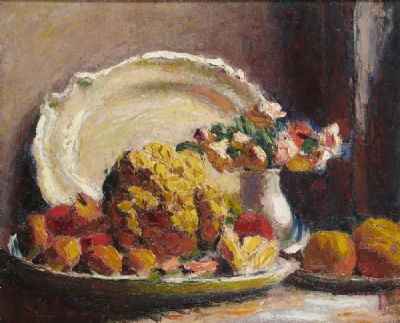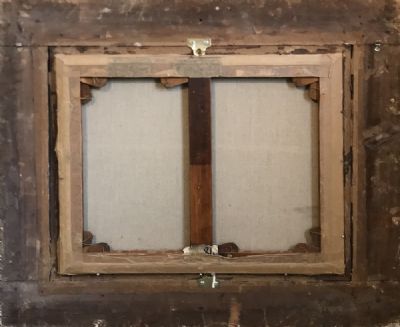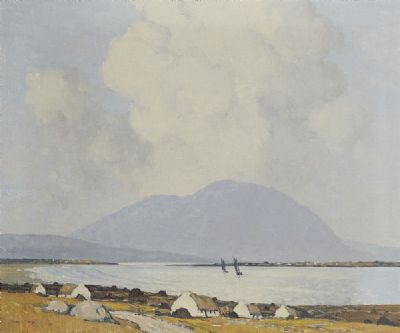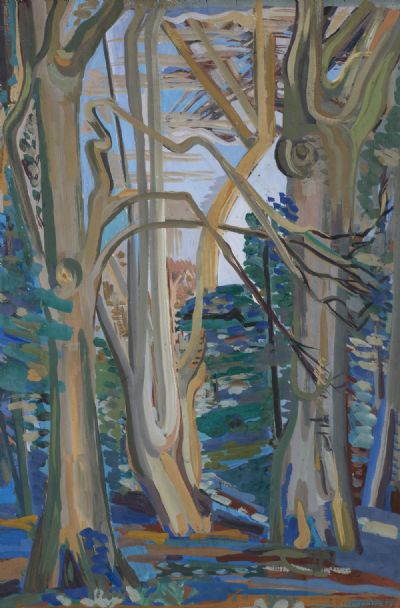Bidding on this item has ended.
Roderic O'Conor
STILL LIFE WITH CAULIFLOWER, VASE OF FLOWERS AND A PLATTER
Lot 28
Price Realised:
€65,000
Estimate:
€60,000 - €90,000
Roderic O'Conor, 1860-1940
STILL LIFE WITH CAULIFLOWER, VASE OF FLOWERS AND A PLATTER, (c.1923-26)
Oil on canvas, 20" x 24" (51 x 61cm), inscribed on the stretcher by the artist: Roderic O'Conor Roses No. 12, and rue du Cherche Midi (the artist's a... Read more
 Lot 28
Roderic O'Conor
STILL LIFE WITH CAULIFLOWER, VASE OF FLOWERS AND A PLATTER
Lot 28
Roderic O'Conor
STILL LIFE WITH CAULIFLOWER, VASE OF FLOWERS AND A PLATTER
STILL LIFE WITH CAULIFLOWER, VASE OF FLOWERS AND A PLATTER, (c.1923-26)
Oil on canvas, 20" x 24" (51 x 61cm), inscribed on the stretcher by the artist: Roderic O'Conor Roses No. 12, and rue du Cherche Midi (the artist's a... Read more
 Lot 28
Roderic O'Conor
STILL LIFE WITH CAULIFLOWER, VASE OF FLOWERS AND A PLATTER
Lot 28
Roderic O'Conor
STILL LIFE WITH CAULIFLOWER, VASE OF FLOWERS AND A PLATTER
Estimate:
€60,000 - €90,000
Roderic O'Conor, 1860-1940
STILL LIFE WITH CAULIFLOWER, VASE OF FLOWERS AND A PLATTER, (c.1923-26)
Oil on canvas, 20" x 24" (51 x 61cm), inscribed on the stretcher by the artist: Roderic O'Conor Roses No. 12, and rue du Cherche Midi (the artist's address), stamped on the reverse: 'atelier O'CONOR'.
Provenance: Studio of the artist, sold Hôtel Drouot, Paris, 7 February 1956; Hôtel Drouot, Paris, 14 October 1968; Schoneman Galleries, New York; Godolphin Gallery, Dublin, 1981; Private collection, Belfast.
Exhibited: Possibly Salon d'Automne, Paris, 1923, no. 1528 'Roses'; London, Barbican Art Gallery, and tour to Ulster Museum Belfast, National Gallery, Dublin and Whitworth Art Gallery, Manchester, Roderic O'Conor 1860-1940, 1985, no. 84, reproduced.
Literature: Jonathan Benington, Roderic O'Conor, a Biography with a Catalogue of his Work, Irish Academic Press, Dublin 1992, page 220, no. 251.
In the 1920s, now in his sixties, O'Conor injected new life into the time-honoured tradition of the 'kitchen' still life - compositions featuring everyday food stuffs and vessels used in the preparation of meals, as celebrated in the work of Northern European artists such as Willem Kalf and Jean-Baptiste-Simeon Chardin.
O'Conor abandoned his former still life props - the pieces of Chinese ceramics, the bronze sculptures and the brightly coloured drapes - that had given some of his earlier pictures an air of artistic refinement. Instead he picked plain serving dishes and everyday cooking ingredients such as shallots, tomatoes, cauliflowers and carrots with their tops still attached, reveling in their contrasting shapes, colours and textures. It was the stuff of the earth, a return perhaps to his days amongst the peasants in Brittany, but with a sideways gesture of solidarity towards the food obsession of his School of Paris associate, Chaïm Soutine, one of whose still lifes was in his private collection. Like the Russian, O'Conor took genuine delight in choosing, handling, arranging and painting these forms in his spacious Parisian studio. He was enthralled by the play of natural daylight across their uneven surfaces, especially when placed close to one of his large studio windows, accentuating the tonal contrasts of the forms, the tabletop and the background.
An inscription by O'Conor on the stretcher bar of this canvas suggests that the title he gave it was 'Roses', perhaps thinking that, by drawing the viewer's attention to the flowers rather than the vegetables, he would render it more appealing to potential buyers. Irrespective, however, of the objects' relative appeal, the entire canvas has been executed with great painterly panache: from the lightest of dragged brushstrokes in the tabletop, to the heavy, almost abstract palette knife work used in the cauliflower and flowers, and finally the delicately brushed shadows and creamy highlights of the serving platter.
O'Conor's 'kitchen' still lifes were admired and purchased by several of his contemporaries. A related larger painting of a cauliflower (without the flowers and platter) was bought direct from the artist by the English novelist, Somerset Maugham, who had known the Irishman since 1905. Others works containing vegetables and fruit were acquired by the English critic Roger Fry, the French artist Maximilien Luce and the American Charles Hall Thorndike. In 1927 an O'Conor flower piece, Le pot chinois, was purchased by the French State and is preserved in the Musee d'Orsay.
Jonathan Benington
STILL LIFE WITH CAULIFLOWER, VASE OF FLOWERS AND A PLATTER, (c.1923-26)
Oil on canvas, 20" x 24" (51 x 61cm), inscribed on the stretcher by the artist: Roderic O'Conor Roses No. 12, and rue du Cherche Midi (the artist's address), stamped on the reverse: 'atelier O'CONOR'.
Provenance: Studio of the artist, sold Hôtel Drouot, Paris, 7 February 1956; Hôtel Drouot, Paris, 14 October 1968; Schoneman Galleries, New York; Godolphin Gallery, Dublin, 1981; Private collection, Belfast.
Exhibited: Possibly Salon d'Automne, Paris, 1923, no. 1528 'Roses'; London, Barbican Art Gallery, and tour to Ulster Museum Belfast, National Gallery, Dublin and Whitworth Art Gallery, Manchester, Roderic O'Conor 1860-1940, 1985, no. 84, reproduced.
Literature: Jonathan Benington, Roderic O'Conor, a Biography with a Catalogue of his Work, Irish Academic Press, Dublin 1992, page 220, no. 251.
In the 1920s, now in his sixties, O'Conor injected new life into the time-honoured tradition of the 'kitchen' still life - compositions featuring everyday food stuffs and vessels used in the preparation of meals, as celebrated in the work of Northern European artists such as Willem Kalf and Jean-Baptiste-Simeon Chardin.
O'Conor abandoned his former still life props - the pieces of Chinese ceramics, the bronze sculptures and the brightly coloured drapes - that had given some of his earlier pictures an air of artistic refinement. Instead he picked plain serving dishes and everyday cooking ingredients such as shallots, tomatoes, cauliflowers and carrots with their tops still attached, reveling in their contrasting shapes, colours and textures. It was the stuff of the earth, a return perhaps to his days amongst the peasants in Brittany, but with a sideways gesture of solidarity towards the food obsession of his School of Paris associate, Chaïm Soutine, one of whose still lifes was in his private collection. Like the Russian, O'Conor took genuine delight in choosing, handling, arranging and painting these forms in his spacious Parisian studio. He was enthralled by the play of natural daylight across their uneven surfaces, especially when placed close to one of his large studio windows, accentuating the tonal contrasts of the forms, the tabletop and the background.
An inscription by O'Conor on the stretcher bar of this canvas suggests that the title he gave it was 'Roses', perhaps thinking that, by drawing the viewer's attention to the flowers rather than the vegetables, he would render it more appealing to potential buyers. Irrespective, however, of the objects' relative appeal, the entire canvas has been executed with great painterly panache: from the lightest of dragged brushstrokes in the tabletop, to the heavy, almost abstract palette knife work used in the cauliflower and flowers, and finally the delicately brushed shadows and creamy highlights of the serving platter.
O'Conor's 'kitchen' still lifes were admired and purchased by several of his contemporaries. A related larger painting of a cauliflower (without the flowers and platter) was bought direct from the artist by the English novelist, Somerset Maugham, who had known the Irishman since 1905. Others works containing vegetables and fruit were acquired by the English critic Roger Fry, the French artist Maximilien Luce and the American Charles Hall Thorndike. In 1927 an O'Conor flower piece, Le pot chinois, was purchased by the French State and is preserved in the Musee d'Orsay.
Jonathan Benington
- Enquire
- View all lots by this artist
- How bidding works
Please note: You will require a deVeres account in order to bid. Please register via the website. Each lot will close numerically. If there is late bidding the time may be extended which could delay subsequent lots. The lots will start to close from 2.00pm on auction day, closing at 45 second intervals.
PLEASE BID EARLY TO AVOID DISAPPOINTMENT.
In order to allow rival bidders the opportunity to respond to a late bid the following extensions will apply:
IF A BID IS RECEIVED WITHIN THE FINAL 45 SECONDS OF THE COUNTDOWN THE CLOCK WILL RESET TO 60 SECONDS.
At any point you can leave a maximum bid, representing the highest price you are prepared to pay for a particular lot. Bidding only advances when there is competition from a rival bidder. In that case the system bids on your behalf, only up to the maximum if required. All bids are relayed to you be email, along with notification if you have been outbid.
All maximum bids are confidential and not disclosed. The system will endeavor to purchase the lot for you for the least price. Bids are subject to buyer’s premium of 25% (incl vat), with no additional charges.
In the event of a tied bid, the preference will be given to the bid submitted first. The second bidder will receive immediate notification of being outbid.
PLEASE BID EARLY TO AVOID DISAPPOINTMENT.
In order to allow rival bidders the opportunity to respond to a late bid the following extensions will apply:
IF A BID IS RECEIVED WITHIN THE FINAL 45 SECONDS OF THE COUNTDOWN THE CLOCK WILL RESET TO 60 SECONDS.
At any point you can leave a maximum bid, representing the highest price you are prepared to pay for a particular lot. Bidding only advances when there is competition from a rival bidder. In that case the system bids on your behalf, only up to the maximum if required. All bids are relayed to you be email, along with notification if you have been outbid.
All maximum bids are confidential and not disclosed. The system will endeavor to purchase the lot for you for the least price. Bids are subject to buyer’s premium of 25% (incl vat), with no additional charges.
In the event of a tied bid, the preference will be given to the bid submitted first. The second bidder will receive immediate notification of being outbid.
Sign-up to our auction alert
Signup for personalised Irish art recommendations, invitations to viewings and auctions, articles and more.





 View More Videos
View More Videos DVTV Click Here To View Video
DVTV Click Here To View Video


